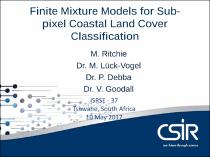JavaScript is disabled for your browser. Some features of this site may not work without it.
- ResearchSpace
- →
- Research Publications/Outputs
- →
- Conference Publications
- →
- View Item
| dc.contributor.author |
Ritchie, Michaela C

|
|
| dc.contributor.author |
Lück-Vogel, Melanie

|
|
| dc.contributor.author |
Debba, Pravesh

|
|
| dc.contributor.author |
Goodall, V

|
|
| dc.date.accessioned | 2017-05-30T06:37:37Z | |
| dc.date.available | 2017-05-30T06:37:37Z | |
| dc.date.issued | 2017-05 | |
| dc.identifier.citation | Ritchie, M.C., Lück-Vogel, M., Debba, P. et al. 2017. Finite mixture models for sub-pixel coastal land cover classification. International Symposium of Remote Sensing of the Environment, CSIR ICC, Pretoria, 8-12 May 2017 | en_US |
| dc.identifier.uri | http://hdl.handle.net/10204/9107 | |
| dc.description | International Symposium of Remote Sensing of the Environment, CSIR ICC, Pretoria, 8-12 May 2017 | en_US |
| dc.description.abstract | Medium spatial resolution sensors (10-30 m pixel size) have been used for land cover classification and monitoring for decades. However, these sensors do not have the required resolution to detect coastal specific land cover classes and boundaries thereof as the spatial extent of the target features frequently is too small (e.g. bands of dune vegetation or the water line). Higher resolution satellite imagery which would be more suitable is, however, frequently too costly for operational coastal monitoring and management. A solution for this problem might be the spectral unmixing classification approach on medium resolution imagery (e.g. Landsat 8; Sentinel-2) which have no acquisition cost and are therefore affordable for operational use. Finite mixture models have been used to generate sub-pixel land cover classifications, however, traditionally this makes use of mixtures of normal distributions. However, these models fail to represent many land cover classes accurately, as these are usually not normally-distributed. A potential improvement could be to use models using other distributions which are more robust to non-normally distributed feature classes, such as the student-t distribution. This presentation aims to show the results of the fitting of various finite mixture models to land cover class signatures derived from radiometrically corrected WorldView-2 imagery of the Strand region of Cape Town. We aim to determine which finite mixture model best fits the signatures for this region. WorldView-2 imagery is used as it allows for the extraction of pixels with pure spectral signatures that is pixels containing one land cover class. However, the long-term goal of this project is to apply finite mixture models for the monitoring of land cover using medium resolution imagery (Landsat 8; Sentinel-2). If successful, this will provide a more robust land cover classification algorithm, which is affordable, for routine monitoring land cover in coastal environments. | en_US |
| dc.language.iso | en | en_US |
| dc.relation.ispartofseries | Worklist;19056 | |
| dc.subject | Remote sensing | en_US |
| dc.subject | Land cover classification | en_US |
| dc.subject | False Bay | en_US |
| dc.title | Finite mixture models for sub-pixel coastal land cover classification | en_US |
| dc.type | Conference Presentation | en_US |
| dc.identifier.apacitation | Ritchie, M. C., Lück-Vogel, M., Debba, P., & Goodall, V. (2017). Finite mixture models for sub-pixel coastal land cover classification. http://hdl.handle.net/10204/9107 | en_ZA |
| dc.identifier.chicagocitation | Ritchie, Michaela C, Melanie Lück-Vogel, Pravesh Debba, and V Goodall. "Finite mixture models for sub-pixel coastal land cover classification." (2017): http://hdl.handle.net/10204/9107 | en_ZA |
| dc.identifier.vancouvercitation | Ritchie MC, Lück-Vogel M, Debba P, Goodall V, Finite mixture models for sub-pixel coastal land cover classification; 2017. http://hdl.handle.net/10204/9107 . | en_ZA |
| dc.identifier.ris | TY - Conference Presentation AU - Ritchie, Michaela C AU - Lück-Vogel, Melanie AU - Debba, Pravesh AU - Goodall, V AB - Medium spatial resolution sensors (10-30 m pixel size) have been used for land cover classification and monitoring for decades. However, these sensors do not have the required resolution to detect coastal specific land cover classes and boundaries thereof as the spatial extent of the target features frequently is too small (e.g. bands of dune vegetation or the water line). Higher resolution satellite imagery which would be more suitable is, however, frequently too costly for operational coastal monitoring and management. A solution for this problem might be the spectral unmixing classification approach on medium resolution imagery (e.g. Landsat 8; Sentinel-2) which have no acquisition cost and are therefore affordable for operational use. Finite mixture models have been used to generate sub-pixel land cover classifications, however, traditionally this makes use of mixtures of normal distributions. However, these models fail to represent many land cover classes accurately, as these are usually not normally-distributed. A potential improvement could be to use models using other distributions which are more robust to non-normally distributed feature classes, such as the student-t distribution. This presentation aims to show the results of the fitting of various finite mixture models to land cover class signatures derived from radiometrically corrected WorldView-2 imagery of the Strand region of Cape Town. We aim to determine which finite mixture model best fits the signatures for this region. WorldView-2 imagery is used as it allows for the extraction of pixels with pure spectral signatures that is pixels containing one land cover class. However, the long-term goal of this project is to apply finite mixture models for the monitoring of land cover using medium resolution imagery (Landsat 8; Sentinel-2). If successful, this will provide a more robust land cover classification algorithm, which is affordable, for routine monitoring land cover in coastal environments. DA - 2017-05 DB - ResearchSpace DP - CSIR KW - Remote sensing KW - Land cover classification KW - False Bay LK - https://researchspace.csir.co.za PY - 2017 T1 - Finite mixture models for sub-pixel coastal land cover classification TI - Finite mixture models for sub-pixel coastal land cover classification UR - http://hdl.handle.net/10204/9107 ER - | en_ZA |






